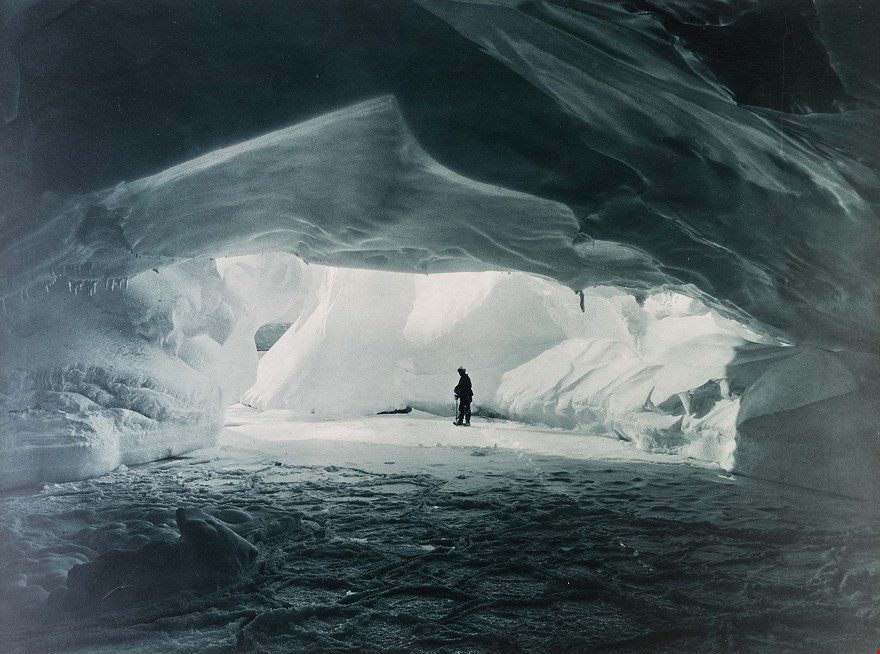A Cavern beneath the Coastal Ice Cliffs.
HURLEY Frank (1914].)
£42500.00
Please contact us in advance if you would like to view this book at our Curzon Street shop.
FROM THE COLLECTION OF EXPEDITION LEADER DOUGLAS MAWSON
Blue-carbon print. 585 by 440mm. Mounted on board with the original Fine Art Society label on the verso, titled in manuscript and numbered "95". A very fine copy with deep tones, minor areas of retouching done at time of printing. London, Fine Art Society, [c.
One of the finest images from the Heroic Age, demonstrating Hurley's complete command of the medium. This example was previously in the collection of expedition leader, Douglas Mawson.
Frank Hurley (1885-1962) started life as a photographer at the age of seventeen, and held his first exhibition in 1910. "He was particularly interested in pictorialism - the notion that photographs could express ideas, tell stories and excite emotions in much the same way as paintings" (Howgego). As soon as the position of photographer was advertised, Hurley applied immediately to join Mawson's expedition. Of course, hundreds had applied. However, over the course of an impromptu train journey he managed to convince him. It was on "the basis of his work with Mawson [that] he was recommended to Shackleton's expedition of 1914, during which he took the famous photographs of the sinking of the Endurance. He was renowned for going to any length to obtain precisely the image he wanted" (ibid).
A depiction of surgeon Leslie Whetter on the Australasian Antarctic Expedition, 1911-1914. This photograph is reproduced in Mawson’s official account Home of the Blizzard (London, 1915), with the caption "On the frozen sea in a cavern eaten out by the waves under the coastal ice-cliffs."
The New Zealand born Whetter (1888-1955) studied medicine at the University of Otago and was one of eighteen men chosen by Mawson to stay with him on the Main Base, while another seven were sent under Frank Wild's command of the Western Party. Whetter distinguished himself on the expedition by performing dental surgery on Chief Medical Officer, Archibald McLean, using chloroform as an anaesthetic. However, it wasn't all smooth sailing. Mawson fell out with a number of men on the expedition, including Whetter. In his diary, Mawson complains of his laziness saying "Whetter is not fit for a polar expedition... Of late he complains of overwork, and only does an honest 2 hours per day" (Riffenburgh). Those words were perhaps written in the heat of the moment, as Whetter is one of two men captured trying to cut ice from a glacier in the dramatic photograph "In the blizzard". They did this daily and used the ice for drinking water.
Mawson (1882-1958), a noted Australian geologist, first travelled to the Antarctic with Shackleton's Nimrod expedition in 1907. When Scott later invited him to join his ill-fated Terra Nova expedition, Mawson declined as he was organising his own to the Australasian Antarctic in 1911. This expedition was aimed at conducting scientific and geographical research in King George V Land and Adelie Land, and also to chase a chief prize of the Heroic Age: a visit to the South Magnetic Pole. Mawson has been somewhat overlooked in the assessment of the Heroic Age. However, his achievement's are every bit as significant as those of Amundsen, Scott, and Shackleton.
Original Hurley vintage prints are increasingly scarce on the market, especially in fine condition, and with such distinguished provenance.
Howgego, M28, M29; Riffenburgh, Beau, Racing With Death, London, 2009.
It would be satisfying to think that Hurley's " A Cavern..." was a response to Ponting's famous "Ice Cave", the latter looking out through a geomorphic window towards the Terra Nova at anchor, a photograph that has achieved a deserved iconic status. Hurley, though, turns the viewers thoughts inward toward the unknown subterranean interior of the continent in a composition that apart from the inclusion of a figure, for scale, seems entirely abstract, and yet echoes somehow the knightly qualities of the heroic age. Unfortunately the chronology does not fit, and it is most unlikely Hurley saw the "Ice Cave" until his return. This exceptional image does combine, uniquely in my opinion, several factors. Firstly it is very rare, secondly it is a sublime composition, thirdly it is in impressive condition, the, sometimes fugitive, blue tones are as richly dark as intended by the photographer, and fourthly it has an unequalled provenance, what more could one want.
Stock Code: 228491




